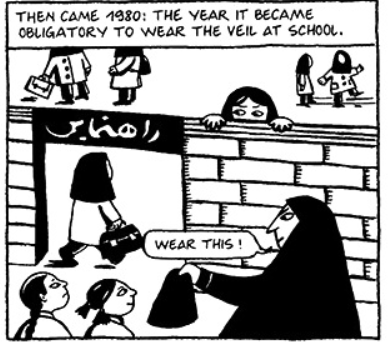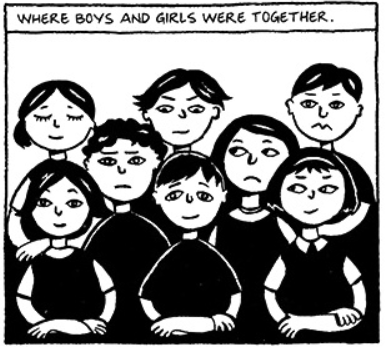Introduction
Persepolis is a novel by Marjane Satrapi, published in 2003. The novel explores many important themes such as family life in the context of the Iranian Revolution, political tension, expectations, cultural differences, and others. This book consists primarily of graphic representation, so the novel received the status of a graphic novel. It is essential to look at how Marjane Satrapi uses graphic memoir format to reflect her experiences of growing up and how her personality struggles with the expectations of Revolutionary Iran females.
Author’s Growing-Up Experience in Persepolis and Graphic Representation
The novel discovers disturbing topics of nurturing during complicated political background. It is worth mentioning that the author uses comics to describe her feelings through various dimensions of time and contexts. For instance, the book starts with the author’s image being a small girl and conveys the Islamic Revolution in 1979. The chapter ‘The veil’ demonstrates that the law made it necessary for children to wear the veil at school. Satrapi shows that she doesn’t appreciate this experience: “we didn’t really like to wear the veil, especially since we didn’t understand why we had to” (Satrapi 3). It indicates that the Islamic Revolution made it compulsory to impose rules on children who were not explained why they should wear this object. It is seen that girls’ faces are gloomy; it demonstrates their unwillingness and total misunderstanding caused by the rule.

It is known that the author belonged to a French non-religious school the year before the Revolution. Boys and girls studied together; probably, children did not lack communication. In the picture below, the graphic illustration helps to understand the difference that influenced children’s perceptions: there were happy boys and girls (Satrapi 2). However, when the rule was imposed, children were deprived of their happy childhood: they became skittles in political games of the capitalist system. The graphic representation shows misunderstandings caused by adults, who were delighted to support new-appeared ideas. Indeed, juveniles wanted to have freedom, to enjoy their childhood, but they were separated from the ability to have it.

As the time flowed, the author grew up, but there was still an incomprehension and desperation in her eyes. She is painted as gloomy and unhappy; the author draws a picture of her previous religious experience. “I was born with religion,” – the author said, and wanted to bring something fair and kind into the world (Satrapi 6). The author had her own inner God, as she communicated and appealed to him: “Every night I had a big discussion with God” (Satrapi 8). Her parents “were puzzled” and wanted her to get a decent job rather than agree with her inner stance (Satrapi 9). The truth is the girl wanted to become a prophet to deliver justice and love. However, she had to suit her parents’ expectations and desires.
It is worth mentioning that the author uses the example of her parents-children relations as a metaphor for expressing more extended thought. She uses relationships as a demonstrative tool for communicating and appealing to the external world; the conflicts she experiences influence her growth. Indeed, it is noticeable that her parents strive to give her all the best; they want to provide her with the best education and decent job title. The author’s family is described to have some privileges; for instance, her father had a Cadillac, and their family had a servant (Satrapi 6). Indeed, she does not understand her parents, who strive to fight for liberation for the working classes, having luxurious facilities simultaneously. She is confused about the fact that her parents’ political views and actions vary significantly.
One more struggle is how the author’s parents reflected on her growing-up experience. Marjane’s mother was one of the followers of revolutionary ideology, striving to create a new, strong nation. She says: “It is not for you and me to do justice” (Satrapi 46). The idea is Marjane’s parents establish their political views in left-wing ideology, practicing a liberal mindset. Indeed, the opinions of Marjane and her parents vary significantly: “The reason for my shame and the Revolution is the same: the difference between social classes” (Satrapi 33). The author does not understand why her parents appreciate such ideology: she feels separation between herself and other girls. For example, her maid, Mehri, is prohibited from having relations with a man because of different social classes. Girls after Revolution were expected to follow these rules strictly, creating a unified society where everyone got what they were meant to receive. Indeed, the author struggles with it; she experiences a crisis of identity during revolutionary events.
Conclusion
Overall, the graphic memoir of Marjane Satrapi helps represent the expectations of Revolutionary Iran. Indeed, it is impossible to touch upon the only topic when speaking about childhood experiences. It becomes apparent that the influences of the Revolution had a significant impact on the author’s personality. She conflicted with the expectations imposed by girls in Revolutionary Iran: the author struggled with disparities that moved her away from other females. The social status difference played a significant role in what was expected and what her parents did: Marjane’s parents responded to the conflict reluctantly; they were swallowed by ideology. Therefore, the author’s experiences in Revolutionary Iran reflect views on political, social, and family disparities.
Work Cited
Satrapi, Marjane. Persepolis: The Story of a Childhood. 1st Edition, Pantheon, 2004.